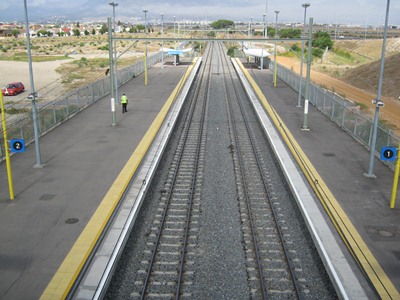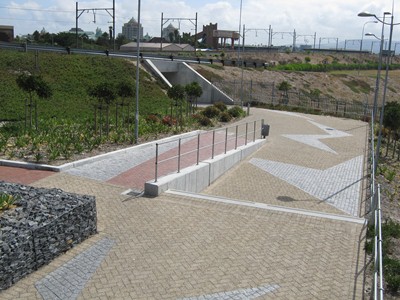
Towards the end of the 1990's a large tract of unused land north-east of Cape Town and alongside the N1 national road was fenced in. Little development took place initially, but large signs proclaimed the area as Century City. Since then Century City has expanded rapidly and can now be regarded as a "mini city" in its own right - it boasts the largest shopping centre in the Western Cape (Canal Walk), a Disney-style amusement park (Ratanga Junction), hotels, restaurants, acres of houses, apartment blocks and retirement villages and an extensive area of smart office blocks. There is a lake in the middle fed by canals from a large rehabilitated wetland, thus providing a sort of waterfront feel even though the whole place is miles from the sea. And it is still expanding - every weekend the Cape Town newspapers contain large sales notices for some new apartment block or office block that is being constructed or has just been completed.




However, despite having two railway lines from Cape Town passing by right next to it, Century City has always been quite a difficult place to get to by public transport. The nearest station (Acacia Park) was a few kilometres away and bus routes were sporadic at best. But thousands of people go to work there every day, only a small fraction of whom are fortunate enough to be able to drive to their place of employment in their own cars. What about all the others? Cleaners, waiters, shop assistants, office clerks and the multitude of other jobs that are needed to keep a community of that size functioning?
The Soccer World Cup that was held in South Africa in 2010 was the catalyst for at least a partial solution to this problem. The authorities had decreed that no cars would be allowed in the vicinity of the stadiums hosting World Cup matches, and given that Cape Town's stadium was very near the city centre (where there is very little parking for cars) the only way to convey thousands of spectators to each match was by public transport. Cape Town's commuter rail network was to be the backbone of the system and several stations on each of the lines that radiated out from Cape Town were identified as "park and ride" facilities - spectators would be able to park their cars in a guarded, secure area near the station and catch a train to the match. For the duration of the World Cup train services were extended and on match days special late trains departed from Cape Town to ensure that people could get home after each match was over (see my blog describing a visit to Cape Town stadium).
But no obvious "park and ride" station existed on the rail line that ran alongside Century City. The tens of thousands of people who lived in Century City itself as well as the vast suburbs around it (Milnerton, Edgemead, Bothasig, Monte Vista, Tableview, Blouberg, etc) would have to drive a long way to other "park and ride" stations (such as Bellville), and these would probably not be able to cope with the demand. But there was acres of parking at Century City, just a short distance from a functioning commuter rail line, so the solution was a no-brainer - build a station at Century City and use it as a "park and ride" during the World Cup. Doing this would have the added advantage of providing future rail access to Century City for workers, shoppers and commuters.
Construction duly commenced in 2009 and after 13 months of work Century City train station was formally opened on 8 June 2010 by S'bu Ndebele, South Africa's Minister of Transport (although this was only three days before the first World Cup match in Cape Town, trains and commuters had already been using the station for about a week). The station is nine kilometres from Cape Town and more or less mid-way between the existing stations of Kentemade and Acacia Park. The scheduled journey time to or from Cape Town is 16 minutes ; it is 17 minutes to or from Bellville in the other direction.

The entire project cost 60 million SA Rands (about 8.75 million US Dollars) and was an overwhelming success. Hundreds of thousands of people used the station during the World Cup, and not only on match days - people were taking the train into the city centre just to experience the "Fan Walk" to the stadium or to watch matches elsewhere on the huge TV screens that were placed on the Grand Parade. Many locals who had never been on a train in their lives before used MetroRail for the first time, although it must be said that most of them went straight back to their cars once the World Cup was over.
On Saturday 3 March 2012, nearly two years after the 2010 World Cup, I took a train to Century City to have a look for myself. To get there from Cape Town's southern suburbs, I had to take a train to Cape Town and change trains there. This took much longer than I thought it would - trains on the Cape Town-Century City-Bellville line on Saturday are very infrequent, often an hour or more apart, so I had a long wait at Cape Town station. I eventually boarded the 10:07 train (number 2813 from platform 22) which left on time and deposited me at Century City at 10:23. The train was quite empty, which I found surprizing for a Saturday morning ; the much more frequent trains on the Southern Suburbs line are usually packed with people on Saturdays. Very few people got on or off the train at any of the intermediate stations, but at Century City there was a general exodus for the doors, implying that if it wasn't for the new station this line would hardly be used at all.
Century City station is certainly impressive. The line is double-tracked with two platforms and an overhead concourse for the ticket offices and entrance/exit - no dark and dingy subways here. The concourse is modern and bright, gleamingly tiled, with an electronic board showing the times of the next few trains in each direction and exit barriers similar to those in use on the London Underground. Directional signage is very clear. It certainly looks like no expense was spared in constructing a showpiece station for MetroRail, and I have no doubt that the people who used the station during the World Cup were suitably impressed.
However, reality intruded on this sleepy Saturday morning two years after the euphoria of the World Cup had ended - the electronic board was completely blank (out of order or switched off ... who knows?) and the automatic ticket barriers were open and not in use. I simply walked through and needn't have bothered buying a ticket. The ticket office outside the barriers was manned by two women but no other personnel were in evidence.
The station has been built next to the Sable Road off-ramp from the N1 national road. Sable Road is the road into the Century City complex from the N1 and formerly ran in only one direction (north-west towards Milnerton) ; it has been extended a short distance in the other direction so that the road now passes alongside the new station and terminates in a dead end with a turning loop. This allows cars to drop passengers at the station entrance, turn round and go back the way they've come.
Pedestrian access from the station to Century City is via this new section of road, onto the Sable Road bridge over the N1 (six lanes of high-speed traffic at this point) and then down a newly-constructed walkway on the other side of the N1. This walkway is beautifully paved and landscaped and descends beneath the northbound Sable Road on-ramp to the N1. At street level it becomes a paved path, securely fenced and well-lit, that meanders into the Century City complex past Ratanga Junction, finally entering Canal Walk shopping centre near the Checkers supermarket. The walkway and path is wheelchair-friendly, with a zig-zag ramp down from Sable Road as an alternative to a series of steps. The walk from the station to the Canal Walk entrance took about ten minutes.
My impressions of the new Century City rail service are:
The last few points above do not bode well for the long-term future of the Century City rail service. The situation is a vicious circle - unless there are more frequent trains, people won't use the service ; but as long as the existing trains remain 80% empty there is no reason why more trains should be allocated to the route. So what is the solution? I have no idea, but I hope that this superbly-constructed new station does not slowly fall into disrepair through lack of use.
 © Paul Kilfoil, Cape Town, South Africa
© Paul Kilfoil, Cape Town, South Africa